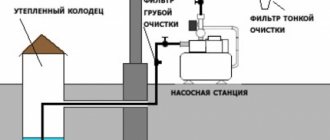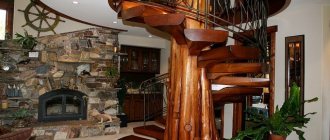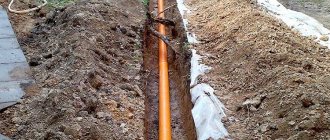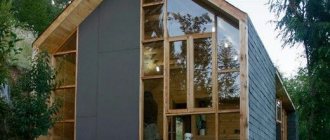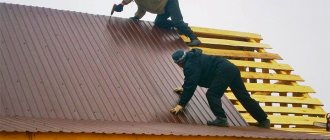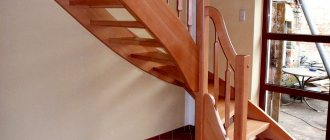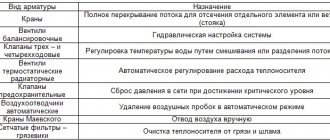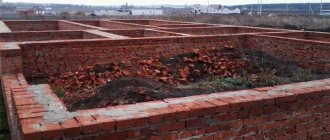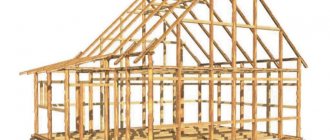Sometimes it happens that the purchased house brings not only the pleasant hassle of creating comfort in your home, but also a headache in the form of mold and damp areas in the corners of the walls. Constant humidity in the basement is a direct indication that the waterproofing is of poor quality or is completely missing. If this moment is missed during the construction process, all that remains is to waterproof the foundation of an already built house as quickly as possible with your own hands or through the efforts of professional builders.
As a result of the negligent attitude of builders to moisture protection of basement walls and foundation surfaces, moisture present in the soil can be absorbed by concrete structures and spread throughout the building. The most effective waterproofing is done before the building is put into operation. But in a residential building, even if it is made of a wooden frame, it is impossible to raise the walls and strengthen the foundation with waterproofing. At the same time, there are a number of ways to protect a building from moisture even after putting it into operation.
Is it possible to waterproof the foundation of an already built house?
Protecting the foundation from getting wet in an already built house is a complex task. Since existing walls limit access to part of the foundation surface, vertical waterproofing and partially horizontal waterproofing are performed. As a rule, the foundation of a residential building already has some kind of finishing and is equipped with a blind area. Whether to destroy the concrete structure that serves to drain water from the foundation or to only waterproof the surfaces accessible for treatment depends on the budget and the condition of the building material of the structure.
It is much easier to protect the foundation of a house if the house is not equipped with a blind area or its dismantling does not involve large-scale work. In such a situation, the technology for waterproofing the foundation of a built house includes the following steps:
- excavation of the external vertical side of the foundation around the house;
- removal of soil residues from the surface, inspection and sealing of cracks;
- performing waterproofing;
- laying a blind area around the house.
The choice of materials and method of waterproofing an old foundation will depend on the condition of the surface, its density and the adhesion of the insulating coating. You need to know how close the aquifer is to the surface. It is the rise in groundwater levels that can become the main reason for the foundation and basement walls getting wet. If you do not take measures to eliminate the risk of flooding, you may one day find a pool in an unsuitable basement.
Waterproofing the foundation around the house is an important point in arranging a warm and durable home, so the choice of materials and method of solving the problem must be approached thoroughly.
Waterproofing
Waterproofing the foundation without outside intervention, with your own hands, of an already built house has significant differences from similar work that is carried out during construction. In the most common version (strip foundation), the main protection against moisture is installed while digging the pit.
It is lined with clay, compacted and a roll of insulation - roofing felt - is laid under the sole. In the case when the house has already been built, most of the work is crossed off from this list.
The main task comes down to:
- Internal insulation.
- Arrangement of the drainage system.
- External protection of the base.
Surface preparation
The main problem that a master faces when working with the foundation of a built house is the need to destroy the blind area and remove the existing finishing. If possible, the foundation should be excavated to its foundation. Next, to ensure good adhesion of the protective coating to the structure, the surface is thoroughly cleaned of soil and debris.
Inspecting the integrity of the structure, repair all cracks and chips on the surface, first using a primer, then a special plaster. The application of the protective coating begins only after the repaired areas have hardened. Waterproofing the foundation of an old house can be done in several ways.
Internal waterproofing of the plinth
- The seams between the slabs that have undergone cracking are cleaned of old mortar. This should be done at least 5 cm deep.
- All surfaces are treated with an antiseptic composition.
- You must wait until the composition dries. At the same time, the floor is thoroughly cleaned and filled with a polymer-based waterproofing compound. After about a day, when the composition has set, a reinforcement mesh is placed.
- Make a screed of concrete or cement with a thickness of about 50 mm.
- In a week you will be able to walk on the screed. At this stage, all gaps are filled with sealant, which will provide high-quality insulation.
- The sealant is diluted to a more liquid consistency and completely covers all vertical surfaces.
https://youtube.com/watch?v=09Uwu6Jvjo0
Pasted waterproofing
As protection against water penetration into the concrete base, roofing felt, polymer membranes and other roll products are used. Depending on the method of attachment to the surface, materials can be welded or glued.
The most affordable and not very durable materials are glued to the structure after all the preparatory materials have been carried out on a layer of bitumen mastic. It provides good adhesion to the foundation. Laying of the deposited materials is carried out using a gas burner. Modern rolled materials usually have an adhesive surface, which, when softened, firmly adheres to the concrete structure and provides reliable protection from water.
The foundation surface must be clean, level and dry before laying waterproofing. For ease of installation, measured sheets of roofing material or film are rolled up with the wrong side up and straightened from below as they are glued. Heating the adhesive side of the material with a gas burner, apply it to the foundation and press it well. Glue the edges of the material overlapping, paying attention to the tightness of the seams.
As for the quality of roll materials, it is better to pay attention to more expensive and effective analogues made on the basis of fiberglass. Flexible and resistant to temperature changes, these materials do not rot or crumble, unlike cardboard-based roofing felt.
External waterproofing
There are several types of it:
- Mountable.
- Penetrating.
- Pasting.
- Coating.
If you want to do all the work yourself and without outside interference, and at the same time reliably and efficiently, it is better to combine the last 2 varieties and give preference to roofing felt as a material. This material provides reliable protection, it is inexpensive and very easy to work with.
Sequencing:
- A trench is being dug around the house close to the base. It is recommended to provide a blind area at this stage. Without it, reliable water protection cannot be achieved. To combine 2 actions, excavation must be done one meter wide, and as deep as the base of the foundation.
- Detected defects must be eliminated: cracks should be sealed with cement mortar, fungal colonies should be cleaned, the base should be treated with household bleach - this is the cheapest and most reliable antiseptic.
- The dried and cleaned base must be coated with bitumen mastic. You can use ready-made soft ones, or in the form of bars. In the latter case, it should be melted to a liquefied state and applied hot. The mastic layer should be at least 2 millimeters thick.
- When the impregnation has dried, the foundation must be painted again. In this case, there is no need to wait until the mastic sets: it is used as an adhesive.
- The waterproofing material is heated with a burner until elasticity appears, after which it is glued to the mastic. The next strip must be laid overlapping the previous one (10 cm overlap).
- The joints are processed with a torch again and lubricated with mastic. As a result, you should get a solid shell without gaps.
Waterproofing with roofing felt is a reliable thing! However, it can be easily damaged when backfilling the trench. We recommend that you build additional protection. You can lay out a brick wall along the entire base - this is a reliable method, but expensive and labor-intensive. In most cases, plastering is done followed by ironing (rubbing cement paste into the foundation).
Coating waterproofing
Waterproofing using coating agents is preferred primarily because of the simplicity of the technology and the ability to process any type of foundation: brick, concrete or stone. To create a reliable protective layer, surface leveling is not required, as is required by roll waterproofing. Coating-type mixtures are produced using bitumen, rubber and polymers.
Mastic can be applied hot or cold. It is preferable to choose a type of mastic that does not require heating and can be used even in the cold season. Their efficiency is quite high, but the reliability of the coating will still be higher if additional roll materials are used.
If only bitumen or bitumen-polymer mastic is used, the protective coating is applied in several layers. Each layer is carefully distributed over the surface and applied only over the hardened previous coating. For good adhesion, it is necessary to treat the structure with a primer before the first application. Since the reliability of adhesion to the surface of the entire coating depends on the combination of mastic and primer, when purchasing products you should carefully read the manufacturer’s recommendations. It is better to use complex protection consisting of primer and bitumen mastic of the same brand.
Roof and roof waterproofing
Roof waterproofing
Here things are more complicated. Whether we like it or not, we still have to use PVC or plastic film. Otherwise, the roof insulation will quickly lose its effectiveness, unless we plan to insulate with polyurethane foam, which is much more effective than fiberglass counterparts.
- Vapor-proof film - stuffed on the inside of the roof sheathing. Protects the insulation from getting wet from the inside. In fact, it is ordinary polyethylene
- Vapor-permeable membrane - laid on top of the insulation on the tile side. It prevents moisture from entering the insulation from the outside, and also allows steam to escape outside without accumulating in the basalt wool.
It is not recommended to damage the integrity of the film, so it is better to use polymer adhesives for fastening. They smeared it, stuck it on, and forgot about it.
If there are serviceable areas on the roof, you can waterproof them using rolled bitumen materials. We have already described above how this is done. The option with liquid rubber is no worse. It is applied with a regular brush or roller to a clean base. It will last longer, maintaining efficiency, as it is more resistant to external influences, including mechanical ones.
Polymer cement waterproofing
A fairly accessible method for independent use, which consists of simply applying a special composition to the surface of the foundation. The undeniable advantage of this treatment method is that all cracks and irregularities in the concrete base do not need to be sealed first. Two-component compositions are distinguished by strength, which is provided by cement, and elasticity, due to polymer substances. You can buy such mixtures ready-made or in the form of a dry powder, which must be diluted before use.
Polymer-cement plaster is not hygroscopic due to the introduction of polymer fillers into its composition, which improve its properties. It perfectly protects the outer surface of the foundation from precipitation and capillary moisture of the surface layers of the soil. But, unfortunately, shrinkage of the soil or rising groundwater can cause it to peel off.
Compared to bitumen-polymer coatings, polymer-cement coatings are more resistant to mechanical damage. The presence of large stones and plant roots cannot affect the durability of the protection. Before coating, the surface of the foundation is slightly moistened.
Plaster is applied in the traditional way, using a spatula. The thickness of each layer must be at least 1 cm. To strengthen the moisture-proof coating, a reinforcing mesh is laid on the first layer. After complete polymerization of the first layer, two more such layers are applied alternately. The method of waterproofing with polymer-cement mixtures is the least expensive and simplest in comparison with other methods. It does not require any special knowledge, skills or tools.
How does moisture affect the foundation?
Water damages the integrity of the foundation in at least two ways.
First of all, this is the washing out of concrete, the appearance of roughness and potholes on its surface.
No less dangerous is the icing of water that has entered the pores of concrete. When water freezes, it tends to expand in volume rather than contract. Penetrating inside the foundation structure, when frozen, it destroys it inside, forming cracks and crevices. Therefore, during construction, waterproofing of the foundation should be carried out during the construction process.
Foundation destruction due to lack of waterproofing
Materials for foundation waterproofing
All materials used to protect foundations from moisture can be divided into the following groups:
- coating;
- sprayable;
- roll;
- penetrating;
- plastering;
- screen waterproofing.
Let's take a closer look at each of them.
I) Coating waterproofing is a bitumen-based material that is applied to the surface (often in 2-3 layers) using a brush, roller or spatula. Such coatings are usually called bitumen mastics. You can make them yourself or purchase them ready-made, poured into buckets.
Recipe for homemade bitumen mastic: buy a briquette of bitumen, split it into small pieces (the smaller, the faster it will melt), pour into a metal container and put on fire until completely melted. Then remove the bucket from the heat and add waste oil, or better yet, diesel fuel (20-30% of the volume of mastic), and mix everything thoroughly with a wooden stick. How this is done is shown in the following video:
Ready-made bitumen mastic is sold in buckets. Before use, for more convenient application, it is usually mixed with the addition of some solvent, for example, solvent, white spirit, etc. This is always indicated in the instructions on the label. There are several manufacturers of such mastics with different prices and different characteristics of the finished coating. The main thing when buying them is not to make a mistake and not take material, for example, for roofing or something else.
Before applying bitumen mastic, it is recommended to clean the concrete surface from dirt and prime it. The primer is made with a special composition, the so-called bitumen primer. It is also sold in stores and has a thinner consistency than mastic. Coating waterproofing is applied in several layers, each of which after the previous one has hardened. The total thickness of the coating reaches 5 mm.
This technology is one of the cheapest compared to those described below. But it also has its drawbacks, such as the short durability of the coating (especially when prepared independently), the long duration of the work and high labor costs. The process of applying mastic with a brush is shown in the following video:
II) Sprayed waterproofing or so-called “liquid rubber” is a bitumen-latex emulsion that can be applied to the foundation using a special sprayer. This technology is more progressive than the previous one, because allows you to perform work with higher quality and in a fairly short period of time. Unfortunately, mechanization of work significantly affects its cost.
The characteristics of liquid rubber and the process of its spraying are shown in the following video:
III) Roll waterproofing is a bitumen or polymer modified material, previously applied to any base. The simplest example is the well-known roofing felt with a paper base. In the production of more modern materials, fiberglass, fiberglass, and polyester are used as the basis.
Such materials are more expensive, but also much higher quality and durable. There are two ways to work with roll waterproofing - gluing and fusing. Gluing is carried out on a surface previously primed with a bitumen primer using various bitumen mastics. Fusing is carried out by heating the material with a gas or gasoline burner and then gluing it. How this is done is shown in the following video:
The use of rolled materials significantly increases the durability of foundation waterproofing compared, for example, with coating materials. They are also quite affordable. The disadvantages include the difficulty of performing the work. It is quite difficult for an inexperienced person to do everything efficiently. You also can't do the job alone.
The appearance of self-adhesive materials on the market several years ago made it much easier to work with roll waterproofing. How to protect the foundation with their help is shown in the following video:
IV) Penetrating waterproofing is a coating of concrete with special compounds that penetrate 10-20 cm into its thickness through pores and crystallize inside, thereby clogging the passages for moisture. In addition, the frost resistance of concrete and its protection from chemically aggressive groundwater increases.
These compounds (Penetron, Hydrotex, Aquatron, etc.) are quite expensive and have not found wide application for complete waterproofing of the foundation in a circle. They are more often used to eliminate leaks in already built and operated basements from the inside, when it is no longer possible to repair the waterproofing from the outside using other methods.
The following video describes the properties of penetrating materials and their correct use in more detail:
V) Plaster waterproofing is, by and large, a type of coating insulation, only here it is not bituminous materials that are used, but special dry mixtures with the addition of waterproof components. Prepared plasters are applied with a spatula, trowel or brush. For greater strength and to prevent cracks, a plaster mesh can be used.
The advantage of this technology is the simplicity and speed of application of materials. The downside is the low durability of the waterproofing layer and lower water resistance compared to the materials described above. The use of waterproofing plasters is more appropriate for leveling the surfaces of foundations or, for example, for sealing seams in foundations made of FBS blocks, before subsequently covering them with bitumen or roll waterproofing.
VI) Screen waterproofing - this is sometimes called the protection of foundations from moisture using special swelling bentonite mats. This technology, which is essentially a replacement for the traditional clay castle, appeared relatively recently. The mats are attached to the foundation with dowels overlapping each other. More details about what this material is and its properties are discussed in the following video:
Penetrating waterproofing
Ideal water resistance is ensured by penetrating waterproofing. The composition of such products uses silicates, which, together with water, penetrate into microcracks and cavities in concrete. When they react with concrete chemicals, they turn into crystals and fill all the small pores. This creates a barrier to incoming moisture from the outside. The product is applied either superficially or by injection.
For independent waterproofing of the foundation of a private house, the second option is too labor-intensive and expensive. But surface treatment of the base of the house is usually carried out quickly and without difficulty. An important condition for good penetration of the mixture into concrete is its good moisture. Within 2-3 hours after treatment, the surface is moistened again using a sprayer.
The advantage of this method is its ease of processing and effectiveness, which is superior to all of the listed waterproofing methods. The success of using penetrating mixtures is that they qualitatively improve the structure of concrete, eliminating all pores and cracks. Detachment, damage or scattering of the protection is impossible due to the fact that there is simply no protective layer. The concrete structure itself becomes waterproof.
Waterproofing an old foundation with your own hands is not always effective, especially if the foundation is quite worn out. It is important to soberly assess your strengths and capabilities. In particularly difficult situations, it would be appropriate to use the services of professional builders. But even a novice craftsman can do the minimum amount of work to protect a worn-out structure.
Main types and methods of waterproofing foundations
Before choosing materials and method for waterproofing, you should know that it can be vertical and horizontal.
The first type is designed to protect the foundation of the house from the effects primarily of groundwater, and the method of its construction is selected both from the type of the foundation itself and from the peculiarities of the geological situation on the site. This method is most effective if there is a reliable drainage system.
Horizontal waterproofing, first of all, protects against so-called “capillary” moisture, the appearance of which is largely associated with precipitation.
It is a mandatory element of any type of foundation for a wooden house. It represents the protection of the horizontal surface of the foundation using various membrane materials on a bitumen, polymer or synthetic basis.
The most popular and well-known product for this is roofing felt, which does not allow moisture to rise up and cause the walls of the house to get wet. If there is a basement, as a rule, horizontal waterproofing is carried out simultaneously on two levels: on the upper and lower sides of the floor slab.
Horizontal waterproofing, video:
Variety of vertical waterproofing
To install vertical waterproofing, depending on the material chosen for this, the following methods can be used:
- coating, for which mastics are used, often bitumen-based;
- the pasting option involves the use of roll or sheet materials such as roofing felt, glass insulation, technoelast and others;
- screen - for this method, bentonite mats are used, which are fixed to the foundation with the help of fasteners, and an additional concrete screen wall is erected close to the protected foundation. These mats contain ordinary clay, so this method is a modern and more reliable modification of the “clay castle”, built around the foundation using a bulk method of clay and gravel, which has a drainage function. But we must take into account that the installation of such waterproofing of the foundation and blind area in tandem is mandatory, since only in this case the effectiveness of this method will be sufficient;
- penetrating - for this option of waterproofing, materials are used that are capable of penetrating as deeply as possible into the thickness of the foundation, simultaneously crystallizing and thus forming a reliable barrier to water. For this method, ready-made compounds are used, which are applied, for example, if a monolithic base is being protected, on fresh concrete;
- The plaster waterproofing method is used in cases where leveling the foundation surface is required. It is recommended to use special hydrophobic compounds or add moisture-resistant additives to the cement-sand mortar. Its independent use is ineffective; in addition, the method of coating waterproofing is used or a reliable clay castle is installed.
Often, to ensure maximum protection, waterproofing methods can be combined with each other, taking into account the characteristics of the geological situation, type of foundation and other factors.
How to choose the right method and type of waterproofing for the foundation?
Despite the variety of materials and options for installing waterproofing for the foundation of a house, the choice is determined not only by the desire of the developer, financial capabilities, but also by such objective factors as:
- characteristics of the soil and, in particular, the strength of its heaving;
- groundwater level;
- structural differences in the foundation itself.
It is not easy to immediately determine which waterproofing is better if all factors are not taken into account. Therefore, this issue should be thought about at the design stage - in this case it is easiest to take into account all the points, especially taking into account the choice of the type of base.
Even if the groundwater level is located deeper than the lowest point of the foundation, its seasonal fluctuations should be taken into account: as a rule, it rises during the period of melting snow or heavy rains.
But since the effect of water on the base is not constant, the best choice is the coating method, for example, using bitumen insulation.
If the groundwater is located deep enough (a meter or more from the lower boundary of the foundation), then some developers, in an effort to reduce costs, neglect to perform this type of work.
In principle, this is possible, but only under ideal conditions. But even if seasonal fluctuations are not terrible, it should be borne in mind that the building will be erected for more than a dozen years. During your stay in the house, so-called long-term fluctuations in the groundwater level may periodically be observed, during which the geological picture changes dramatically.
In addition, the density of development changes over time, new hydraulic structures may appear in the adjacent territory, for example, the installation of drainage systems in neighboring areas or the laying of transport highways nearby, which will also contribute to the geological situation, sometimes changing it radically.
Therefore, to protect against unpleasant “surprises” in the future, you should take care of the reliability and durability of your home in advance and do a minimum of coating or penetrating waterproofing.
In what other situations is waterproofing required for foundations?
In situations where the level of groundwater is critically high, it will be necessary to waterproof the foundation with rolled materials , as well as the creation of an effective drainage system, which will play the role of reducing water, and therefore reducing the negative impact of water on the foundation of the house.
It is impossible to do without waterproofing work even if construction is carried out on so-called complex soils and, above all, water-resistant soils, which are clay and loamy soils.
In this case, the water level, of course, matters, but even if it lies deep enough, protective measures are a necessity.
The danger comes not from groundwater, but from surface water: flood or sediment. Since they, not being able to seep into the lower layers of the soil, look for the path of least resistance and head towards the foundation, for which they pose a serious threat.
When choosing a waterproofing method, you should also pay attention to such an aspect as the chemical composition of groundwater, which can be a fairly aggressive environment for concrete structures. And in this situation, not only reliable waterproofing will be required, but also the correct choice of waterproof concrete grades when constructing the foundation.
Installation of material on the horizontal part of the foundation
Step by step steps:
- Use a brush to remove dust from the base on which the foundation will be built.
- Treat it with bitumen primer. This will ensure better adhesion of the waterproofing material to the base.
- It takes approximately 24 hours for the bitumen primer to dry. After the specified time has elapsed, check it by pressing it with a dry cloth folded several times. If it remains clean, you can begin installing the waterproofing material.
- Take measurements of the base under the foundation, and cut waterproofing material based on them.
- Trim and carefully remove the protective film on the waterproofing, retreating 10-15 cm from the edge.
- Glue the waterproofing sheet to the base, making sure that no voids or air bubbles form.
- Use a stitching roller to smooth the material.
- Lay the next sheet in the same way. For better adhesion, clean the joint area from dust. After placing the material, roll this area with a rolling roller. The longitudinal overlap between the canvases should be 10 cm, and the transverse overlap should be 15 cm.
It is important to know!
Before proceeding with further construction of the foundation, it is recommended to protect the foundation from mechanical damage. To do this, you can use cement-sand, asbestos-cement particle boards or fill it with a protective screed.
Insulation of the foundation with waterproofing
The optimal material for insulating the foundation is polystyrene foam. In addition to thermal insulation, it will provide protection from mechanical damage during backfilling of soil, aggressive influence of moisture, and fungus.
Let's look at the step-by-step installation of insulation using XPS CARBON polystyrene foam as an example. The work will require bitumen mastic to place the material below ground level and XPS adhesive foam to fix it above the surface.
Step-by-step installation of insulation on a base below ground level:
- Apply the pre-prepared mastic onto the heat-insulating boards in strips. In this case, the consumption of the composition will be 0.5-1 kg per 1 sq. m. m.
- Install the slabs on a base covered with waterproofing material.
Step-by-step installation of insulation on a base above ground level:
- Remove the gloss from one side of the insulation using a fine-toothed saw.
- Apply foam adhesive in strips of 2-3 cm along the perimeter of the slabs, after shaking the can, keeping a distance of 2 cm from the edge. Make an additional strip in the center.
- After applying the adhesive foam, wait 5-7 minutes for polymerization. After this, install the slab on the base. The individual insulation elements are combined with each other according to the tenon and groove principle. For this purpose, the plates have a special L-edge.
- After the adhesive foam has dried (after about 24 hours), apply additional fixation to plastic facade dowels. It is enough to use 2-3 fasteners per slab.
If the foundation is not insulated
If the foundation is not insulated, a profiled membrane will be installed on the waterproofing material. Let's look at the work using Planter Standard as an example. This is a dense polyethylene canvas with special protrusions 8.5 mm high.
The membrane will protect the waterproofing layer from local mechanical damage when backfilling the foundation during the operation of the building. To install it, you will need a double-sided bitumen-polymer tape 5 cm wide.
Step-by-step installation:
- Cut the ribbon into pieces 5-7 cm long.
- Remove the protective film from them and fix the Planter Standard membrane on top. The protrusions on it should be directed towards the waterproofing material.
- Install the adjacent membrane sheet in the same way. The overlap should be 4 projections.
- Tape the seams on top with bitumen-polymer tape.
- Secure the membrane above the level of the waterproofing material using the Planter profile strip.
